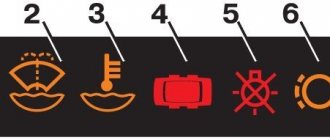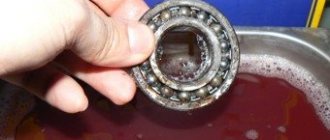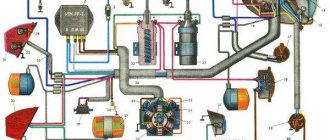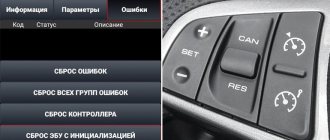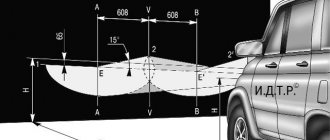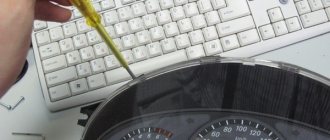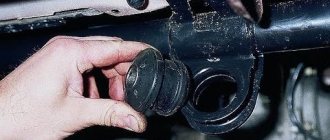How to remove a crankshaft pulley bolt: why is everything so complicated?
A knowledgeable motorist usually spends no more than a quarter of an hour on the process of dismantling the crankshaft pulley. But inexperienced drivers, when trying to remove this part on their own, are faced with many problems that they often simply cannot solve. The instructions for carrying out repair work and maintenance of any modern vehicle contain comprehensive information about the dismantling process, but, unfortunately, it does not help car enthusiasts.
First of all, difficulties arise with fixing the crankshaft. It is very difficult to dismantle it if the part is constantly rotating, “slipping” out of your hands. It is also not clear to many from which side to approach the bolt that holds the pulley. And its strong tightening usually makes the process of removing the unit very, very difficult, since dismantling under such conditions is fraught with damage to the body covering or elements of the car’s engine compartment.
All car manufacturers and car service specialists use great force to tighten the nut or bolt of the crankshaft pulley (on some vehicle models the mechanism is supported by a bolt, in others by a nut).
This is done specifically to avoid self-unwinding of this part during vehicle operation. If a bolt (nut) falls out while driving, it will not be easy to bring the car back to life in order to continue driving it, and the repair itself will cost, believe me, a pretty penny. In addition, the described fasteners increase their tightening level independently when the engine is running. And the final “indestructibility” of the bolt is given by the phenomena of coking, sticking, and corrosion.
How to unscrew (unscrew) a screw or screw without a screwdriver?
The offer is updated regularly, and the number of partners and potential buyers increases every day, from Vladivostok to Kaliningrad - this is why it will become easier and faster for you to buy or sell spare parts by posting or finding the necessary information on the ZiSinfo Portal. When posting information about the sale of spare parts by professional market participants, we excluded the price indication in order to protect partners and private users of the portal from unfair pricing practices. Login Registration. All about spare parts. How to unscrew a bolt: 45 practical recommendations I like 0. Views: I like 0.
Expert answers
I would like to note right away that a bolt that is located in an inconvenient place is difficult or even impossible to remove. Let's say the asterisk is freely available, then there are several ways to remove it.
Using a gas (pipe) wrench. You just need to hold the bolt with a wrench and unscrew it. The clamping force of this tool allows you to unscrew even completely smooth products.
Using a hammer and chisel. This method can safely be called folk. First, a small depression is made so that it is convenient to insert a chisel into it, then several blows are applied with a hammer in the direction of unscrewing, and that’s all.
Restore edges. To do this, use a file or grinder, which is used to apply a new relief pattern. You can also drill a hole in the product and drive a metal rod with edges into it. You can also weld a new nut to the damaged head. If we are talking about small fasteners, then the nut can simply be glued.
You can also do it like this:
Use a grinder to cut the thread for a flat-head screwdriver:
Surprises are inevitable during renovations. Equipment may fail, a seemingly strong part may break in the most unnecessary place, and bolts and nuts may resist unscrewing. And then the repair drags on, taking extra time, nerves and money.
Nowadays you can find many videos on the Internet with guidance on carrying out any repair work. They say that based on videos from the Internet, you can build a house from scratch and reassemble a car, piece by piece.
But with such a huge number of tips and recommendations, it is difficult to choose the right course of action for you. In this article we will try to collect all available experience and systematize it for ease of use.
How to unscrew the sprocket bolt
To unscrew a bolt, you can use the following methods:
- using a grinder or a hacksaw for metal, a clear and neat vertical cut is made across the screw head, after which you can unscrew it with a flat-head screwdriver;
- using a Torx sprocket: you need to hammer it into the head of the hardware, where there is a recess for a hex key, the sprocket should be of such a size that the slots do not fit into its holes, then the hardware is unscrewed with a sharp jerk;
- using a drill with extractors and drills, drill holes in the center of the hexagon, after that the extractor is driven into it, then using pliers it is pulled out together with the hexagon screw;
- a thin hole is drilled with a drill with reverse rotation, then a drill with left rotation is inserted into it and the fasteners are unscrewed.
How to remove a sprocket from a single-speed bicycle (singlespeed)
To remove the transmission sprocket on a single-speed bike, simply release the locking ring. Many singlespeed fans claim that the “original” locking ring is no good and sometimes breaks, even if there is no talk of replacing the sprocket. In any situation, if the stopper fails, you need to replace it. Otherwise, backlash is inevitable. The chain will simply dangle in different directions.
If the sprockets are faulty, the bike will not ride. Timely replacement of transmission parts is important for all models of bikes: from the simplest “hard workers” to the most sophisticated high-speed highway bikes and mountain bikes.
Bolt with torn edges
Now we will figure out how to unscrew a bolt with torn edges . As a rule, the reasons for this problem lie in the following:
- The parts held by the bolt were misaligned in an unnatural way. This leads to pinching and damage.
- The bolt itself was very tight when tightening.
- The tool used to tighten it was the wrong size and improvised means were used (screwdrivers or chisels are often placed in larger keys when there are no suitable small ones).
Before unscrewing a broken bolt or nut, you need to do some preparation. This will allow you to spend less time and effort, and sometimes save expensive equipment.
Sequencing
- Coat the joint with liquid to aid unscrewing. Such a liquid can be the famous WD-40, brake fluid or kerosene. Take your time and let the liquid do its job. As practice shows, you can safely leave the part alone for thirty minutes, or even an hour.
- Take any available tool and lightly, not forcefully, tap the hardware from all accessible sides. Your goal, in this case, is not to launch the bolt like a golf ball, but just to slightly loosen it at the place where it is attached. While performing this activity, there is a danger of damaging the thread, so balance the strength and swing.
- If you have the opportunity and space, try heating the bolt. A gas burner is suitable for this. Make sure there are no flammable liquids or objects near the workplace. Also, before you start warming up, make sure that in case of an emergency you have somewhere to retreat. Do not heat the part with an open flame in enclosed spaces. It is better to open the gate or move the bolt to the air. Rust and grease scorched in this way will turn into ash and will no longer prevent the bolt from being unscrewed.
Methods for removing a bolt
Below are the most effective ways to remove damaged bolts and screws.
With damaged edges
When deciding how to unscrew a bolt with stripped edges, you need to consider whether there is access to it, its location, and what tool you can use. Based on these factors, you can use one of the following methods:
- Using a chisel. The method is suitable for large bolts that have easy access. All you need is a hammer and chisel. The chisel is applied tangentially to the head and sharp blows are applied to it. The method is simple, but it rarely achieves the desired result. It should only be used when there is no other tool at hand.
- If there is free access to the location of the fastener, you can use a universal adjustable wrench. This tool allows you to securely clamp even a round head. If you use small adjustable cobra-type wrenches, which have sharp notches on the working surfaces, you can unscrew the smallest bolts. Such a tool can help out in many cases, but it must be new. In a worn tool, the notches can no longer provide reliable adhesion to the metal, and the key will slip.
If the edges are not severely damaged, then socket wrench heads can help out. For these purposes, the ring wrench profile must have 12 edges (there is an asterisk inside the head, not a hexagon). Unscrewing is done as follows. Select a head one size smaller than the size of the bolt, and use a hammer to press it onto the torn edges, then unscrew it in the usual way.- This method involves using a hacksaw for metal, with which a cut is made on the head of the bolt for a flat screwdriver. The depth of the cut should not be more than 75% of the height of the bolt head; with a greater depth, one of the halves may break off.
- If you have a file or grinder at your disposal, you can restore smaller turnkey edges. If you have an open-end wrench, it is not necessary to cut out a hexagon; it is enough to make two parallel edges.
- If you can use welding at the location of the fastening, this will greatly facilitate the task. In this case, you can put a nut of a suitable diameter on the head and weld them together, and then use regular wrenches.
In difficult cases, in order to achieve the desired result, you need to combine several methods. Therefore, first assess the situation, decide how you can unscrew the bolt, and only then get to work.
With the head torn off
Very often, when disassembling old threaded connections, you can not only damage the edges of the bolt, but also tear off the head. Then the question arises: how to unscrew the broken bolt. If you have separated parts and the broken bolt protrudes from the body of the part, then you can use all of the above methods.
How to unscrew a bolt with a torn head if the body of the bolt does not protrude from the part? There are several options for solving this problem.
- It is best to use a special tool - an extractor. The extractor is made of a cylindrical metal rod, at one end of which there is a conical thread of opposite cutting, and at the other - a square shank. In order for it to be used, a hole must be drilled in the center of the bolt. The hole diameter is 2-3 mm less than the thread diameter. After this, you need to take an extractor of a suitable size and hammer it into the hole with a light blow. Rotating the extractor by the shank, unscrew the remaining bolt.
- If you have a left-hand thread tap, you can successfully use it as an extractor. The only difference is that the diameter of the hole must be the same as for threading. The exact value can be found in the corresponding tables.
- If you still can’t unscrew the fragment, you can try to remove it this way. Drill a hole in the bolt with the largest possible diameter, being careful not to damage the threaded connection. Then take the appropriate tap and cut a thread in the hole. During this process, the threads are cleaned and any remaining bolt residue is removed.
Installation of connecting rod
After dismantling the part and performing all the planned manipulations, it is necessary to return the structural element to its original place. Before carrying out work, it is advisable to clean all surfaces and connections, and then treat them with a thick lubricant. This approach will allow you to install the connecting rod evenly and will significantly facilitate the work if it needs to be dismantled again.
During installation, it is necessary to deeply seat the part on the shaft. This will avoid the appearance of backlash during movement. If the connecting rod is not secured tightly enough, the socket will gradually become unusable. To securely fasten the part, applying a force of about 50-70 Nm is sufficient.
Wrench sizes
Typically, all of the above types are sold in sets with different sizes and diameters. Let's say the small ring key from the set has a ring of 2−4−6−8−10−13−15, and the hexagon and dodecahedron are only even: 4−6−8−10−12−16 and so on. Wrench, socket and tube tools have the same dimensions as ring wrenches. Depending on the type of set, there may be devices for both larger and smaller nut sizes. The same goes for sliding and gas keys. They have their own numbering, and each of them covers only a certain diameter. The main thing is to be able to choose the right ones for you.
How to unscrew a bolt with a licked hexagon or Torx
It is quite easy to lick off the edges on these bolts and subsequently there are difficulties with unscrewing them. I'll tell you a simple way to easily unscrew this bolt.
Hello dear readers!
Today I’ll tell you how to unscrew a licked internal hex or Torx bolt. As practice shows, it is quite easy to tear off the edges of this bolt.
For example, if the hexagon is not inserted completely or is skewed. And how much effort and nerves people subsequently spend on unscrewing these bolts.
Therefore, you must be careful when unscrewing hexagon socket bolts. Make sure that the hexagon fits well and is level, not warped (unless, of course, the bolt has not yet been licked).
Let's look at several ways
*Weld to bolt
If the head of the bolt sticks out and there is a possibility of welding to it. It is necessary to weld another bolt or nuts and unscrew it.
Also, if the head of the bolt sticks out, then it can be turned with a grinder for a key or a head.
This method will help you if the bolt is M8 or smaller in diameter. It is necessary to rest the chisel against the head of the bolt in the direction of unscrewing and use a hammer to unscrew the bolt.
*Use 12 beam bit (Spline)
This method is the easiest and most reliable. I recommend that you start unscrewing the licked bolts (with internal hexagon) from there. Because in most cases the bolt will come out.
In the photo at the beginning of the article, the edges on the generator shaft are licked off (the client came to change the overrunning clutch, as he wrote about how to change it in a separate article). They unscrewed it just using a 12 beam bit.
Why do the edges of a screw, screw or bolt lick off?
Licking is the grinding down of the edges of a bolt or a screwdriver slot on the head of a screw, screw or self-tapping screw. Both masters and beginners can encounter this problem. When the edges of the bolt are licked, the key begins to slip on it and it is not possible to unscrew such an element. The slots on the head of screws and screws can become damaged, which also leads to the screwdriver turning and making it impossible to unscrew the damaged fastener.
Reasons why the splines of a screw, a screw or the edge of a bolt or nut can lick off:
- use of worn tools;
- incorrect use of a wrench or screwdriver;
- poor quality fastener.
If a key or screwdriver slips through while unscrewing the fastener, do not panic and need to figure out the reason. Sometimes it is enough to change the screwdriver or wrench to solve the problem immediately.
Methods for unscrewing bolts, screws, screws with licked edges
If the usual method fails to unscrew the fasteners whose edges have licked off, you can use one of several proven options.
Gas key
This method is used when unscrewing bolts, since they have a protruding head that you can grab onto. For this:
- Clean the bolt head.
- Lubricate the joint with kerosene or diesel fuel, a liquid like WD-40 works well, and leave for 15–20 minutes.
- Unscrew the bolt. They do this with a gas wrench. With its help, a lot of force is created and it is possible to grip even a round head well.
Types of connecting rods
- Single-component - presented in the form of a monolithic structure, where the left and right elements are fixedly mounted on the axis. The advantage of this solution is high reliability, ease of maintenance and low weight due to the lack of fasteners.
- Two-component - the axle, the right connecting rod and the drive sprocket are connected into a single structure. The left connecting rod is attached to the system thanks to a nut fit.
- Three-piece - the most common option. Presented as a separate axle, as well as a right and left connecting rod connected to a sprocket.
Why are fasteners needed?
Fasteners are the most important elements of mechanical engineering, which are used almost everywhere. The most common fasteners that have threads are:
A bolt, like a screw, is a rod with a head that has one threaded end. Screws are usually classified into two types:
- Installation ones that fix the parts mutually.
- Fasteners that are used for detachable connections.
Screw heads can be cross-slotted or single-slotted.
As a rule, this element is necessary if you need to attach an additional element. Often, a machine screw with a countersunk head is used instead of bolts, since the protruding head interferes with some mechanisms.
Most often, screws are used when there is a need to fix parts that have been mounted on shafts or axles.
Types of screws
Let's start with the fact that a screw is a cylindrical rod with a special head onto which a screw groove is applied . Screws are produced according to a number of regulatory documents, including GOST 1144-80, GOST 1145-80, etc.
However, there are two main types of hardware:
- classic screws;
- self-tapping (also known as self-tapping screws).
Carving self-tapping screws for metal and wood
For designation in this case, the diameter and length of the screw are used (for example, a product with a diameter of 5 mm and a length of 3.5 cm will be designated as 5x35 mm). In addition, hardware can be classified according to the shape of the slot and the features of the head itself:
- with a flat (countersunk) head;
- with the same, but smaller type;
- with press washer;
- with a hemispherical head.
Types of screw heads
All of these varieties are produced with a Phillips slot, with a straight (flat) and with a Torx slot (the latter is also known as an “asterisk”), as well as with an internal hexagon and other, less popular options. There are also self-tapping screws with hexagonal and octagonal heads (roofing), which are also made with different slots.
On a note! According to the type of thread, screws are also divided into several varieties, which is determined, first of all, by the materials being connected and the specific purpose (for metal, wood, drywall or small household appliances).
Installing new stars
If you are not messing around with oval sprockets, where you need to precisely select the angle of rotation of the sprocket relative to the connecting rods, then you will not have any difficulties installing new sprockets. The outer star usually has a small pin. The sprocket should be installed so that this pin is directly opposite the connecting rod. This simple design will not allow the chain to get stuck between the sprocket and the connecting rod if it falls off.
The inner star, as a rule, also has such a pin for the same purposes. But if it is not there, pay attention to the inscriptions on the star itself; they should be visible when installing it, that is, they should be turned away from the connecting rod.
After you have aligned the stars, you need to insert the bonks into them and tighten them. You can focus on one bonk. Please note that the inner part of the hexagon or torx mount usually faces outward, that is, it is inserted from the outside of the connecting rods. Insert the inner bonnet and screw the outer one into it. Once you've done this with one bonnet, you'll no longer need to hold the stars in place and try to screw in the rest at the same time. Tighten each bonk sequentially. The sprockets should not be loose, so tighten them well, or use a torque wrench.
Here's a short video to keep you from getting confused:
Why might it be needed?
Removal of the old cassette is necessary for full maintenance. In this case, almost the entire bicycle must be disassembled. If the maintenance was carried out recently, removal will be necessary for the following reasons:
Take the survey
- Depletion of teeth. The top of each tooth should be trapezoidal. Wear is never even. The cassette sprockets that the cyclist uses most often are the first to fail. It is not always necessary to replace every sprocket on a bicycle, but the owner will definitely have to pay attention to their technical condition.
- Violation of factory geometry. The most common cause is branches or other hard objects getting into the space between the chain and the cassette. Folk craftsmen recommend using a file to briefly restore its functionality. But this is only enough to go shopping in search of a new cassette.
- The appearance of a “wave” between the teeth. This is another popular sign indicating that the sprocket has worn out. As the “wave” increases, its service life decreases.
There are also other reasons why a bicycle transmission cassette may need to be removed. They will be mentioned below. But first you need to figure out the sequence of actions before disassembling.
Teeth exhaustion
Violation of factory geometry
The appearance of a “wave” between the teeth
More ways
Other methods include:
- If the bolt is not too small, you can use a chisel or a regular hammer: they strike at an angle in the direction of unscrewing the fastener.
- Using a gas or spanner wrench.
- You can use a wrench with an attachment.
- Welding: it is necessary to weld a little metal with a nut or a piece of reinforcement to the fastener, with the help of which it is then unscrewed.
The last resort is complete dismantling of the fastening, when cuts are made with a hammer and the fasteners are disassembled.
The most important thing when working is not to forget about safety. Care should be taken to protect the face, eyes and hands when carrying out the above manipulations.
How to unscrew a hex or sprocket head bolt
In the automotive industry and other equipment, hex tool bolts are often used. How to turn out a torn cap that has broken edges:
- Make a horizontal notch on the head with a grinder or file. In this case, a strong screwdriver is used to unscrew the broken screw.
- Using a special TORX sprocket, which is driven into the head. The nozzle is selected in size, slightly larger than the torn cap, for a strong connection between the walls.
- A set of extractors that can be purchased at a hardware store. Before using the extractor, a hole is drilled with a drill in the base of the bolt, then the extractor is inserted, and the screw is removed with pliers or a special clamp.
- Using a left-handed drill with a slightly smaller hole diameter. Work with the tool is carried out in reverse mode, with this method it is possible to damage the thread.
Read also: Kirchhoff’s second law determines the ratio
How to unscrew a bolt with torn edges manually
Broken nuts are more difficult to unscrew, since during work there is a possibility of damage to the threads. The simplest way is to use chemicals; the surfaces are cleaned and treated with the product for 15 minutes. If the edges are torn off, it is impossible to use a wrench or socket. In such cases, a chisel is used to destroy the main part of the nut, then removed and replaced with a new nut.
How to remove a bolt if the head has broken off
A broken head of the structure can cause a lot of trouble during work. How to act in such a difficult situation without resorting to using a serious tool. If the element is small, it is possible to make a notch with a grinder, the recess of which will allow the use of a screwdriver with sharp edges. To perform more complex work, you will need an extractor, drill and reamer. The base of the threaded connection is drilled exactly in the middle, after making the hole, the tool is screwed in counterclockwise.
When performing sequential actions, unscrewing a damaged structural element will not be difficult even for those who are encountering this problem for the first time. It is necessary to correctly assess the situation and use a good quality tool for a productive result.
How to drill out a broken bolt
A drill made of high-quality material is used for the work. The size must be selected in accordance with the torn edges; the diameter of the drill should not be larger than the hole. A high-quality drill has a higher price, but its use eliminates rapid wear and the possibility of breakage during operation.
You should use the tool slowly, and before completing the task, correctly assess the situation. It is necessary to monitor the position of the tool during operation; drilling is carried out strictly in the center, without deviations in different directions.
Cutting metal strip
The first thing to do is measure the length of the edge of the hexagon for which you need to make a key.
We multiply this size by six (the number of edges), and we get the length of the metal strip that needs to be cut.
I recommend adding 6 mm to the resulting length (which I didn’t do), then it will be easier for you at the next stage of manufacturing.
The plate should be wider than the height of the bolt for which you are making the key (a couple of millimeters is enough).
Preparatory work
Regardless of the reasons that caused problems with unscrewing the bolt, it is worth carrying out a number of preparatory works, and only then proceeding with plumbing operations.
- Open the bolted joint with penetrating fluid, which will greatly reduce the coefficient of friction. It is advisable to use WD-40, kerosene or brake fluid as such a liquid. After the liquid is applied to the problem joint, you should wait 30-60 minutes, and only then begin to unwind.
- You can first tap the stuck hardware (for example, with a hammer). This must be done carefully so as not to damage the thread itself.
- You can (if the location allows) heat a stuck bolt with a gas burner, which will cause the rust and dirt to turn into ash, and the metal itself will become somewhat more pliable.
How to make a bicycle puller with your own hands
A lock nut puller cannot be made at home; a lathe is required. But to make a whip, you just need to take four long screws, an ordinary thick board and an old bicycle chain. The sequence of actions will be as follows:
- The master places the board strictly vertically.
- A chain twisted in three must be attached to the top of the board.
- Two self-tapping screws are screwed on top between the pins of the chain so that they hit the top of the board.
- You also need to screw a self-tapping screw on the left and right sides of the board, preventing the chain from “walking.”
Having placed the chain on the cassette sprockets, you can begin to unscrew the lock nut. For ease of storage, if desired, a small hook is screwed to the bottom of the board, from which you can hang the structure. Such a homemade tool will save a decent amount and will last for quite a long time.
Preparatory work
Regardless of the reasons that caused problems with unscrewing the bolt, it is worth carrying out a number of preparatory works, and only then proceeding with plumbing operations.
How to unscrew a licked bolt
When turning the bolt, pry it up with a nail puller and pull it out to the maximum possible height, leave it in tension and gradually unscrew it with a wrench. When you don't have a nail puller, you can use a screwdriver. A small bolt is removed using pliers by the head. If it does not give in immediately, then rotate it, clamping it with pliers counterclockwise with upward force.
Use a tap and insert it all the way. If you don’t have it at hand, then a screwdriver with a cone-shaped edge will do, which you carefully hammer in until it stops and try to unscrew it.
To prevent such situations from reoccurring, they must be treated with graphite lubricant before tightening the bolts. But solid oil or lithol are not used for this purpose, because they are used for rubbing parts, and after lubrication, bolted joints become jammed with them.
How to replace sprockets?
1. Unless your goal is to just replace the outer sprocket - which can easily be done by removing the fasteners and threading it through the connecting rod - you will have to start by removing the drive sprockets.
2. Some high-quality connecting rod systems allow you to remove the sprocket bolts with regular hex keys or special Torx wrenches, but if your sprockets have regular bolts, you will need either a special puller that fits into the cut recess of the sprocket nut or another hex key (often 1 mm larger than the front one), holding the nut from turning.
A special key - a puller holds the sprocket nut motionless while unscrewing or screwing the bolt.
Lock the nut and unscrew the bolts in a counterclockwise direction. Carefully remove them; they will be useful for installing new sprockets. You can now remove the old front sprockets or clean them thoroughly if you are only replacing the outer sprocket to change the gear ratio.

